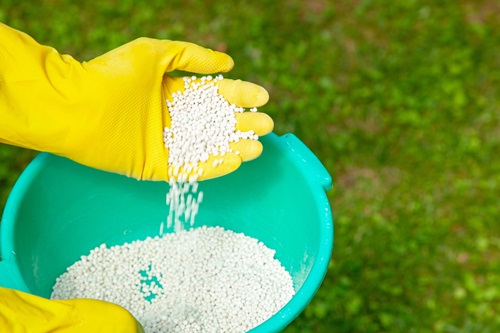
If you’re eager to establish a beautiful new lawn, fertilizing is crucial. Whether you’re seeding a fresh yard, laying down sod, or overseeding an existing area, giving your new grass every opportunity to thrive is essential. Fertilizing plays a vital role in this process because it provides essential nutrients that help your new seeds develop a robust root system. So, what type of fertilizer should you use, and how can you apply it effectively? Let’s explore some helpful tips on fertilizing your new lawn to set you up for success.
Choosing the Right Fertilizer for Your New Grass
When it comes to fertilizing your lawn, not all products are created equal. Therefore, the first step in achieving a vibrant lawn is to perform a soil test. This simple process allows you to identify nutrient deficiencies and determine what your soil needs. Many garden centers offer DIY soil testing kits that are user-friendly and effective.
For most homeowners, a starter fertilizer is the best choice for new grass. These fertilizers contain a balanced mix of nitrogen, phosphorus, and potassium (commonly referred to as NPK), along with essential micronutrients. Notably, starter fertilizers typically have higher-than-average amounts of phosphorus, which is crucial for root development. When choosing a fertilizer, look for an NPK ratio with the middle number—representing phosphorus—being the highest.
Timing Your Fertilizing Application
Timing plays a significant role in the success of your new lawn. If you are planting cool-season grass, such as Kentucky bluegrass or fescue, the optimal time for seeding and fertilizing is in the fall. However, if you live in a warmer climate and are seeding warm-season grass like Bermuda or Zoysia, aim for spring or early summer.
When it comes to adding fertilizer, you can choose to fertilize either before or after planting your new grass seed. Experts generally recommend applying fertilizer before seeding to ensure that the nutrients are available to the seeds right from the start. This proactive approach reduces the risk of fertilizer burn and promotes healthier growth. For sod installations, always fertilize the soil beforehand.

fertilizing in Conway SC
Effective Techniques for Fertilizing Your Lawn
Now that you’re ready to use your new grass fertilizer, start by prepping your lawn to create the ideal conditions for fertilizing in Conway SC. Begin by removing any debris, such as leaves, rocks, and twigs. Next, loosen the top layer of soil using a rake or rototiller. If you’re applying fertilizer first, this is the perfect time to do so.
Fertilizers typically come in two forms: granules and liquids. If you’re using granules, spread them evenly across your lawn with a drop or broadcast spreader, or even by hand (just remember to wear gloves!). For liquid fertilizers, a hose sprayer works well for easy application. Regardless of the type, make sure to cover your lawn in overlapping stripes. A good rule of thumb is to apply 0.5 to 1 pound of nitrogen for every 1,000 square feet of lawn. Additionally, aim to fertilize during cooler times of the day, either early morning or late evening.
After spreading the fertilizer, lightly rake it into the top few inches of soil. However, avoid mixing it too deeply, as your grass seed needs access to those nutrients. Next, evenly distribute your grass seed and rake it into the top layer of the soil. Remember, you can also choose to fertilize for new grass after seeding if that better fits your timeline.
Understanding the Effects of Fertilizing on New Grass
If you follow the guidelines on your fertilizer product and apply it correctly, you shouldn’t face any problems with harming your grass. However, over-fertilizing can lead to “fertilizer burn,” which causes brown patches and stunted growth. Therefore, it’s crucial to apply the right amount.
Caring for Your Newly Fertilized Lawn
Applying seeds and fertilizer is just the beginning of nurturing your new lawn. Once you’ve added the fertilizer and grass seed, it’s vital to water your lawn thoroughly. Keeping the soil consistently moist (but not overly saturated) is essential until your grass seeds germinate. For the first week, aim to water twice daily, and then gradually reduce this to once or twice a week in the early morning. Establishing a watering schedule based on your climate zone will help your new grass thrive.
Additionally, it’s best to keep pets and children off the lawn until the grass is well-established, usually around six to eight weeks after germination. After this period, you can transition to a regular fertilization schedule. Fertilizing every other month during the growing season is generally recommended, but seeking expert advice on the right fertilization schedule for your lawn in Conway SC can also provide valuable insights.
Avoiding Common Fertilizing Mistakes
It’s surprisingly easy to over-fertilize your lawn or choose the wrong fertilizer for the needs of your soil. Therefore, if you’re investing time and resources into creating a new lawn or improving a struggling one, consider consulting professionals for assistance.
Conway Lawn Care Service can help you analyze your soil and apply the best fertilizer tailored to your lawn’s specific needs. They can manage every aspect of establishing your new lawn, whether you opt for seeds or sod.
If you’re excited about achieving the best lawn on the block, it’s time to take action. Call Conway Lawn Care Service for professional assistance in making your lawn a vibrant and thriving space!
Conway Lawn Care Service
Conway, SC 29526
843-353-2259
http://conwaylawncareservices.com
No comments:
Post a Comment